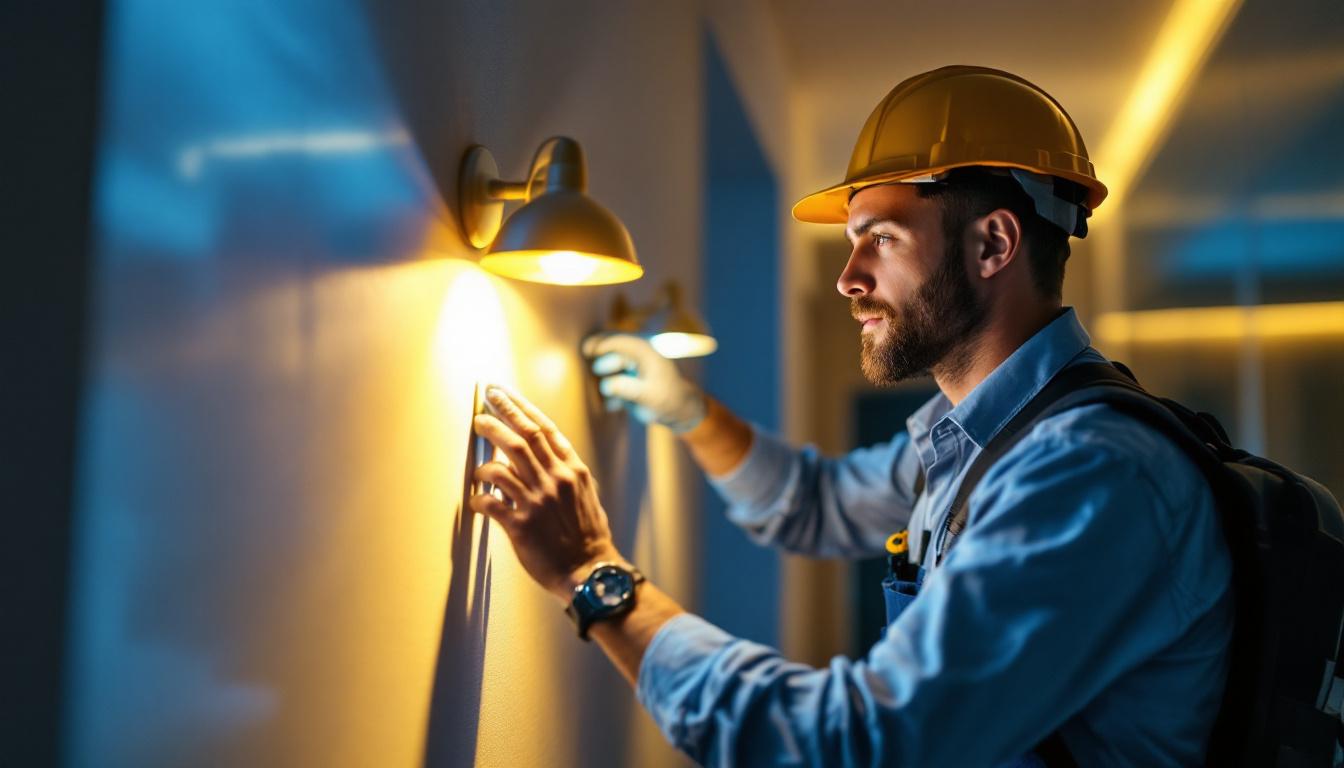
In the realm of smart lighting, 12 volt movement sensors play a pivotal role in enhancing both functionality and energy efficiency. These sensors detect motion within a designated area and trigger lighting systems accordingly, making them indispensable for contractors looking to offer cutting-edge solutions to their clients. Understanding the fundamentals of these sensors is crucial for any lighting contractor aiming to stay ahead in the industry.
12 volt movement sensors operate on low voltage, which not only ensures safety but also allows for easier integration into various lighting systems. Their ability to respond to motion can significantly reduce energy consumption, as lights are only activated when needed. This feature is particularly appealing to environmentally conscious clients looking to minimize their carbon footprint. Moreover, the low voltage operation means that these sensors can be powered by various energy sources, including solar panels, which further enhances their sustainability and appeal in eco-friendly projects.
There are several types of 12 volt movement sensors available, each designed for specific applications and environments. The most common types include passive infrared (PIR) sensors, ultrasonic sensors, and dual technology sensors. Understanding the differences between these types is essential for selecting the right sensor for a given project.
PIR sensors are the most widely used due to their reliability and cost-effectiveness. They detect changes in infrared radiation, which occurs when a person or object moves within their field of view. Ultrasonic sensors, on the other hand, emit sound waves and measure the time it takes for the waves to bounce back. This technology allows them to detect motion even in challenging environments, such as those with obstacles. Dual technology sensors combine both PIR and ultrasonic technologies, providing a more robust solution for detecting movement. By leveraging the strengths of each technology, dual sensors can reduce false alarms and enhance detection accuracy, making them ideal for high-traffic areas.
The versatility of 12 volt movement sensors makes them suitable for a wide range of applications. From residential settings to commercial spaces, these sensors can be integrated into various lighting systems to enhance security, convenience, and energy efficiency. In residential areas, they are often used for outdoor lighting, ensuring that pathways and entrances are illuminated when someone approaches.
In commercial settings, 12 volt movement sensors can be employed in offices, warehouses, and retail spaces. They can automate lighting in response to occupancy, ensuring that lights are only on when needed. This not only saves energy but also extends the lifespan of lighting fixtures, providing additional value to clients. Furthermore, in security applications, these sensors can be linked to alarm systems, providing real-time alerts when unauthorized movement is detected. This integration allows businesses to enhance their security measures without the need for extensive manual monitoring, giving both contractors and clients peace of mind.
Incorporating 12 volt movement sensors into lighting systems offers numerous benefits that can enhance the overall appeal of a contractor’s services. From energy savings to improved safety, these sensors provide a compelling case for their use in various projects.
One of the most significant advantages of 12 volt movement sensors is their ability to conserve energy. By automatically turning lights on and off based on occupancy, these sensors help reduce electricity consumption, leading to lower utility bills for clients. This energy efficiency is not only cost-effective but also aligns with the growing trend of sustainability in the construction and lighting industries.
Moreover, many clients are increasingly aware of their environmental impact. By promoting the use of energy-efficient solutions like 12 volt movement sensors, contractors can position themselves as responsible and forward-thinking professionals. This can lead to more referrals and repeat business as clients appreciate the added value and savings.
Security is a top concern for many clients, particularly in residential and commercial settings. 12 volt movement sensors can significantly enhance security measures by ensuring that outdoor and indoor areas are well-lit when motion is detected. This deters potential intruders and provides peace of mind for homeowners and business owners alike.
In addition to deterring crime, well-lit areas also contribute to safety. Clients will appreciate the added security that comes with motion-activated lighting, especially in areas that are prone to darkness or low visibility. By incorporating these sensors into lighting designs, contractors can offer a comprehensive security solution that meets the needs of their clients.
While the benefits of 12 volt movement sensors are clear, proper installation is crucial to ensure optimal performance. Lighting contractors must consider several factors when integrating these sensors into their projects.
The placement of movement sensors is critical to their effectiveness. Contractors should carefully assess the area where the sensors will be installed to determine the best locations for maximum coverage. Factors such as the layout of the space, potential obstructions, and the typical movement patterns of occupants should all be taken into account.
For outdoor applications, sensors should be positioned to cover entrances, driveways, and pathways. In indoor settings, placing them in hallways, stairwells, and common areas can help ensure that lights activate when needed. Additionally, understanding the sensor’s field of view and range will help contractors achieve optimal performance.
Since 12 volt movement sensors operate on low voltage, proper wiring is essential for safe and effective installation. Contractors should ensure that the wiring used is compatible with the sensor and the overall lighting system. This may involve using specific types of cables or connectors designed for low voltage applications.
Furthermore, compatibility with existing lighting fixtures is another consideration. Contractors must verify that the sensors can seamlessly integrate with the chosen lighting solutions, whether they are LED, incandescent, or other types of fixtures. This attention to detail will help prevent issues during installation and ensure a smooth operation post-installation.
Many 12 volt movement sensors come with programmable features that allow contractors to customize their settings based on the specific needs of their clients. Understanding these features can enhance the overall functionality of the lighting system.
Most movement sensors offer adjustable sensitivity settings, allowing contractors to fine-tune how responsive the sensor is to motion. This is particularly useful in environments where there may be pets or other moving objects that could trigger the sensor unnecessarily. By adjusting the sensitivity, contractors can minimize false alarms and ensure that the lighting system operates efficiently.
Additionally, many sensors come with time delay settings that determine how long the lights will remain on after motion is detected. Contractors can customize this setting based on the specific needs of the space. For instance, in a hallway, a shorter time delay may be appropriate, while in a larger area, a longer delay may be more suitable. This level of customization allows contractors to provide tailored solutions that meet their clients’ expectations.
As smart home technology continues to gain popularity, the ability to integrate 12 volt movement sensors with smart home systems is becoming increasingly important. Many modern sensors can connect to smart home hubs, allowing for seamless control and automation of lighting systems.
Contractors should familiarize themselves with the various smart home platforms available and how to integrate movement sensors into these systems. This may involve configuring settings through a mobile app or enabling voice control features. By offering smart home integration, contractors can appeal to tech-savvy clients looking for modern and convenient lighting solutions.
While 12 volt movement sensors offer numerous benefits, there are also challenges that contractors may encounter during installation and operation. Being aware of these challenges and having solutions ready can enhance the overall client experience.
Environmental factors can significantly impact the performance of movement sensors. For instance, extreme temperatures, humidity, and obstructions can affect their sensitivity and range. Contractors should consider these factors when selecting sensor locations and types.
To mitigate these issues, contractors can conduct thorough site assessments before installation. This allows them to identify potential challenges and choose the most suitable sensors for the environment. Additionally, educating clients about the limitations of movement sensors can help manage expectations and ensure satisfaction.
Regular maintenance is essential for ensuring the longevity and effectiveness of 12 volt movement sensors. Contractors should advise clients on how to maintain their systems, including cleaning the sensors and checking for any obstructions that may hinder performance.
In the event of issues, having a troubleshooting guide can be invaluable. Common problems, such as false triggers or failure to activate, can often be resolved through simple adjustments or resets. Providing clients with this information can enhance their confidence in the system and reduce the need for service calls.
Incorporating 12 volt movement sensors into lighting systems presents a wealth of opportunities for lighting contractors. From enhancing energy efficiency and security to providing customizable solutions, these sensors are a valuable addition to any project. By understanding their functionality, installation considerations, and potential challenges, contractors can position themselves as experts in the field.
As the demand for smart lighting solutions continues to grow, embracing technologies like 12 volt movement sensors will not only benefit contractors but also provide clients with innovative and efficient lighting options. By staying informed and adapting to the evolving landscape of smart lighting, contractors can ensure their success in a competitive market.
Ready to elevate your smart lighting projects with high-quality 12 volt movement sensors? Look no further than LumenWholesale, where we provide contractors with spec-grade lighting products at unbeatable wholesale prices. Our extensive selection is designed to meet the highest industry standards, ensuring you get reliable and high-performance lighting for every project. Plus, with free shipping on bulk orders, you can stock up on the best lighting solutions without worrying about hidden fees or compromises. Don’t miss out on the perfect blend of quality, affordability, and convenience. Visit LumenWholesale today and discover the best value in wholesale lighting!

Discover how Maxlite revolutionizes efficiency for lighting contractors with innovative solutions and cutting-edge technology.

Discover innovative strategies and insider tips for smart lighting contractors in “Light On Post.” This article delves into cutting-edge hacks that enhance efficiency, boost client satisfaction, and elevate your lighting projects to the next level.

Discover how MR16 LED bulbs can revolutionize your lighting projects by enhancing efficiency and reducing energy costs.

Discover the science behind four-foot LED lights and why they’re a game-changer for lighting contractors.